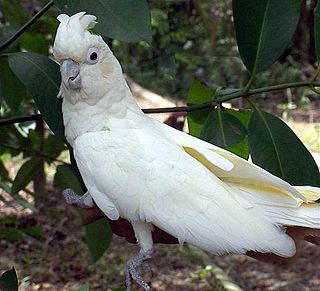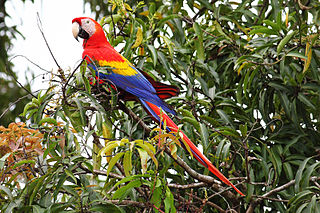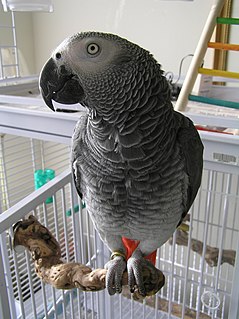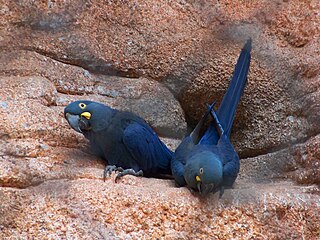
Macaws are long-tailed, often colorful New World parrots.

The palm cockatoo, also known as the goliath cockatoo or great black cockatoo, is a large smoky-grey or black parrot of the cockatoo family native to New Guinea, Aru Islands, and Cape York Peninsula. It has a very large black beak and prominent red cheek patches.

The red-vented cockatoo sometimes called the Philippine cockatoo or kalangay, is a critically endangered species of cockatoo that is endemic to the Philippines. It is roughly the size and shape of the Tanimbar corella, but is easily distinguished by the red feathers around the vent.

African Lion Safari is a family-owned safari park in Southern Ontario, Canada, straddling the cities of Hamilton and Cambridge, located 100 kilometres (62 mi) west of Toronto. Guests may tour seven game reserves via tour buses or visitors' own vehicles where animals roam freely in contained areas. Accompanying the game reserves is a walking section where exotic birds and primates, as well as the park's herd of Asian elephants, are on display.

Anodorhynchus is a genus of large blue macaws from open and semi-open habitats in central and eastern South America. It includes two extant species, the hyacinth macaw and Lear's macaw also known as the indigo macaw, and one probably extinct species, the glaucous macaw. At about 100 centimetres (39 in) in length the hyacinth macaw is the longest parrot in the world. Glaucous and Lear's macaws are exclusively cliff nesters; hyacinth macaws are mostly tree nesters. The three species mainly feed on the nuts from a few species of palms.

The scarlet macaw is a large red, yellow, and blue Central and South American parrot, a member of a large group of Neotropical parrots called macaws. It is native to humid evergreen forests of tropical Central and South America. Range extends from south-eastern Mexico to the Peruvian Amazon, Colombia, Bolivia, Venezuela and Brazil in lowlands of 500 m (1,640 ft) up to 1,000 m (3,281 ft). It has suffered from local extinction through habitat destruction and capture for the parrot trade, but in other areas it remains fairly common. Formerly it ranged north to southern Tamaulipas. It can still be found on the island of Coiba. It is the national bird of Honduras. Like its relative the blue and gold macaw, scarlet macaws are popular birds in aviculture as a result of their striking plumage.

A companion parrot is a parrot kept as a pet that interacts abundantly with their human counterpart. Generally, most species of parrot can make excellent companions.

Lear's macaw, also known as the indigo macaw, is a large all-blue Brazilian parrot, a member of a large group of neotropical parrots known as macaws. It was first described by Charles Lucien Bonaparte in 1856. Lear's macaw is 70–75 cm (28–30 in) long and weighs around 950 g (2.09 lb). It is metallic blue with a faint, often barely visible, tinge of green, and a yellow patch of skin at the base of the heavy, black bill.

The blue-and-yellow macaw, also known as the blue-and-gold macaw, is a large South American parrot with mostly blue top parts and light orange underparts, with gradient hues of green on top of its head. It is a member of the large group of neotropical parrots known as macaws. It inhabits forest, woodland and savannah of tropical South America. They are popular in aviculture because of their striking color, ability to talk, ready availability in the marketplace, and close bonding to humans.

The blue-throated macaw, also known as the Caninde macaw or Wagler's macaw, is a macaw endemic to a small area of north-central Bolivia, known as Los Llanos de Moxos. In 2014 this species was designated by law as a natural patrimony of Bolivia, where it is known as barba azul, which means 'blue beard' in Spanish. Recent population and range estimates suggests that about 350–400 individuals remain in the wild. The main causes of their demise is capture for the pet trade. It is currently considered critically endangered and the parrot is protected by trading prohibitions.

Loro Parque or 'Loro Park' is a 13.5-hectare (33-acre) zoo on the outskirts of Crossport or Puerto de la Cruz on Tenerife, Spain where it houses an extensive and diverse reserve of animal and plant species. The park was conceived as a paradise for parrots and has developed over the years into one of the biggest attractions of the Canary Islands, with over 40 million visitors. The park keeps orcas, which has attracted criticism from some organisations. and led to the zoo being boycotted by major travel agents including TUI Group (Thomson) and Thomas Cook.
Anthony Juniper is a British campaigner, writer, sustainability advisor and environmentalist who served as Executive Director of Friends of the Earth, England, Wales and Northern Ireland. He was Vice Chair of Friends of the Earth International from 2000–2008.

The Blue-winged macaw, in aviculture more commonly known as Illiger's macaw, is a species of macaw found in central and eastern South America. The second name is in honor of the German ornithologist Johann Karl Wilhelm Illiger. It was previously placed in the genus Ara or Propyrrhura. Blue-winged macaws have been known to reach an age of 50–60 years.
Tony Silva is an American aviculturist and ornithologist, and the author of books and articles about parrots. From 1989 to 1992, he was curator of birds at Loro Parque, the largest parrot park in the world. In 1996, he was convicted of conspiring to smuggle rare parrots into the United States and of tax evasion.

The Funds for Endangered Parrots (FbP) is a German non-governmental organisation (NGO) in the field of species conservation, which supports and operates projects worldwide for endangered parrot species.
Al Wabra Wildlife Preservation (AWWP) is a privately owned wildlife preserve in the heart of Qatar founded by Qatari Prince Saud bin Muhammed Al Thani. The preservation accommodates the World Heritage Cycad Gene Bank (WHCGB), which operates in conjunction under formal agreement with several overseas national governments to protect both in situ and ex situ this family of prehistoric plants. The preserve is home to roughly 2,000 animals and has a staff of over 200. It occupies 2.5 square kilometers of land, including a 1,000-square-meter state of the art climate controlled greenhouse.

The Arini tribe of the neotropical parrots is a monophyletic clade of macaws and parakeets characterized by colorful plumage and long, tapering tails. They occur throughout Mexico, Central America, and South America, and formerly the Caribbean and North America. One genus and several species are extinct; another genus is extinct in the wild. Two species are known only through subfossil remains. About a dozen hypothetical extinct species have been described, native to the Caribbean area. Among the Arini are some of the rarest birds in the world, such as Spix's macaw which is extinct in the wild - fewer than 100 specimens survive in captivity. It also contains the largest flighted parrot in the world, the hyacinth macaw.
The American Federation of Aviculture, Inc. (AFA) is a national organization dedicated to aviculture, whose purpose is to educate the public and assist members regarding best practices for keeping and living with exotic birds. Local affiliate bird clubs throughout the United States, including Puerto Rico, along with national and international specialty organizations; comprise the Federation. The American Federation of Aviculture is registered as a non-profit 501(c)3 educational organization, with a business office located in Austin, Texas.















